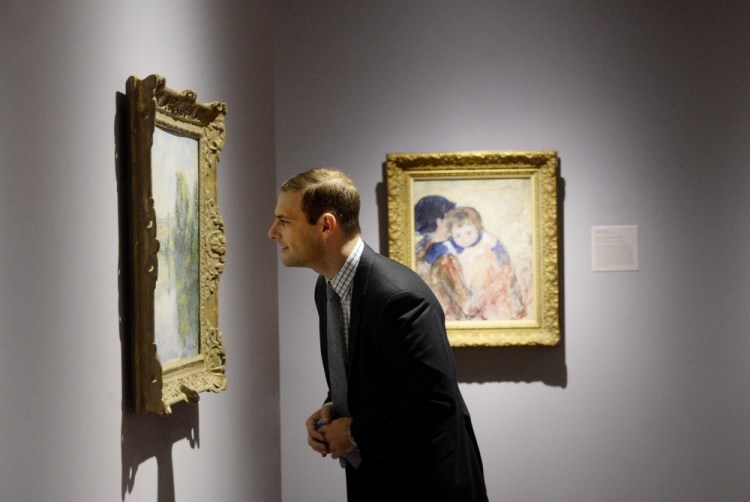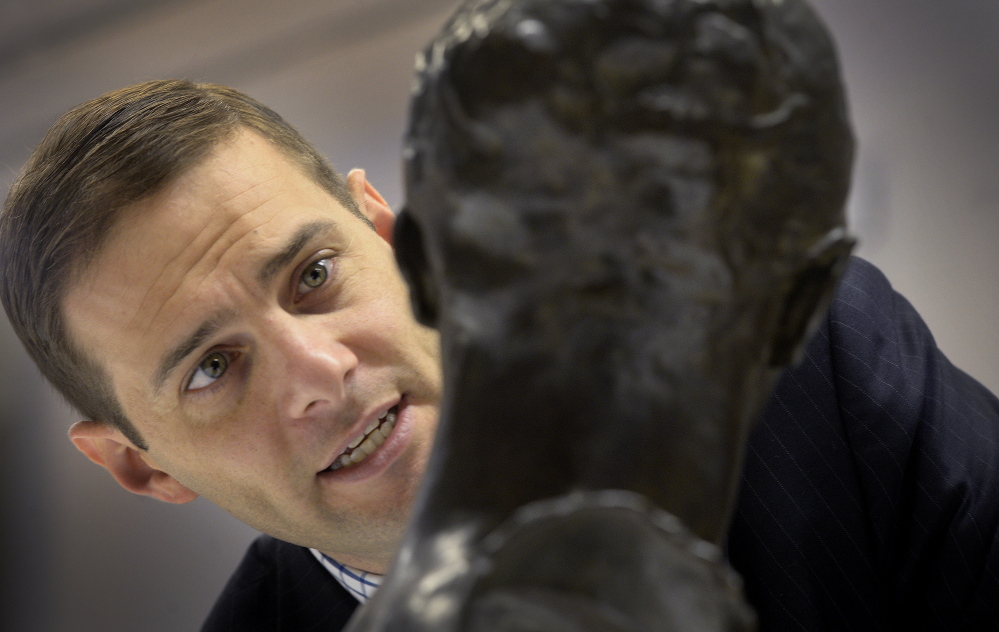Andrew Eschelbacher’s love affair with France began when he was 9 years old. His parents planned to take his older brother and sister to a touring production of the musical “Les Misérables” in Boston. They would include young Andrew if he learned the story in advance.
The challenge spawned in Eschelbacher a deep appreciation for all things French, culminating when he was 20 years old and stood looking up at “The Raft of the Medusa” at the Louvre in Paris. He was overcome with awe and rippling with excitement. The magnificent oil painting by Théodore Géricault shows the graphic, tragic aftermath of the wreck of the French frigate Méduse in 1816.
In that moment, Eschelbacher realized what he wanted to do with his life.
“From that point on, I was really interested in art history,” he said.
In September, Eschelbacher, 34, joined the Portland Museum of Art as assistant curator of European art. His job involves overseeing the museum’s European collection.
He joins a curatorial team that includes chief curator Jessica May, American art curator Karen Sherry and curatorial fellow Diana Greenwold. Together, the four will rehang all the galleries as part of a 2016 strategic plan to reinterpret the museum and its collection.
To prepare, Eschelbacher is learning the collection from the inside out. Last week, he pulled “Bust of Diana,” a bronze by French sculptor Falguiere, out of storage. The piece, which likely came from a middle class French home in the late 19th century, hasn’t been shown in years. “I’m looking for the composition,” Eschelbacher said, bending at the waist to look closely at the sculpture. “I am looking for his handling. He was obviously superb in terms of his modeling and casting.”
He also assessed its general condition. Is it stable? Does it need to be cleaned?
Eschelbacher specializes in 19th- and 20th-century European art, particularly French painting and sculpture. He worked at Petit Palais museum in Paris in 2010-11 and most recently served as assistant professor of art history at the Virginia Military Institute in Lexington, Virginia. He also has taught high school French.
He earned his doctoral degree in art history from the University of Maryland, a master’s in art history at Tulane and a bachelor’s in French and French literature from Davidson College in North Carolina. He grew up on the North Shore in Massachusetts. He and his wife, Suzy, rent an apartment in Portland’s West End.
FALGUIERE, WHO?: His work is close to Eschelbacher. Falguiere was part of Eschelbacher’s dissertation. He described the artist as a sculptor that many Americans who went to France would have known and against whom the avant-garde reacted. Without Falguiere, we would not have gotten to Rodin, he said.
“That’s one of the things I’m trying to think about with the permanent collection. It’s great that we have this European art. But, how does it fit into other stories?”
ART IN THE MILITARY: Virginia Military Institute is a public liberal arts college where students are military cadets. “I was a little intimidated when I first went there, because I don’t have a military background, and going into this military setting was different. But students are students. And in students who choose to go there, we can foster a love of learning. Other than the fact that I wore a uniform, it was totally normal. And the uniform was great – I didn’t have to pick out my clothes.”
MAKING IT RELEVANT: “The statues that we had on campus were a great way to work with students and think about how art functions as part of our society. I used to have them go outside and think about this one statue, ‘Virgina Mourning Her Dead,’ How do we connect this to the tradition of public monuments, and how do we connect it to the local history of the Civil War and to the 21st-century ceremonial traditions? Because one of their major parades is oriented toward that statue.”
ON THE MILITARY CONTEXT: “I remember very distinctly spending a class with my students talking about the Elgin Marbles in the British Museum, and are they British or are they Greek and what do you with them, and how do you resolve these really big issues about cultural patrimony? And here are these students, who have read books like Matthew Bogdanos’ ‘Thieves of Baghdad’ and see the way the military and their future career are very much connected to these cultural issues. The way they have those conversations is from a different approach.”
A CHANGE: “I wanted to come home to New England. I wanted to work with objects, and I wanted to work with a larger group of people. And this may sound grander than I intend it, but I like the idea of public service. We have a great opportunity to play an important role in the cultural life of the city, and Portland is a great city. There is a feeling, there is a vibe, there is a spirit in Portland that is much larger than the actual population. We have a really nice collection here at the museum, and there are great stories to tell that go along with our collection. That’s what we’re thinking about – what are the stories we can tell, what are the stories we want to tell? How can we be a museum that tells a Maine story, that tells an American story, that tells a European story and not tell three separate stories? We want to think about how these three stories all work together.”
ON HOW HE WORKS: Eschelbacher’s job is to observe with the discipline of a scientist and think like a storyteller. In addition to assessing the technical quality of a work of art, he makes connections between works, linking one painting with another, or this artist with that artist. He puts the work into context. Close observers can already see the result of his work. The first week of October, curators removed a painting from a second-floor gallery that had been on loan. That led to 14 other changes on the second floor, including the new pairing of a seascape by Gustave Courbet and a landscape by Claude Monet.
The Courbet had been in storage, and the Monet is among the most popular paintings on view in the museum. They are very different works, the Courbet a detailed and somewhat dark ocean scene, the Monet a painting full of happiness and light.
Hanging them side by side “allows us to see the progression of Courbet, how he uses the palette knife to create creases and texture in his surfaces. … We don’t get to Monet and the way Monet creates his surfaces without Courbet. My job is to tell that story, to make the connections so the art means something more than just a pretty painting hanging on the wall,” he said.
THE BIGGER PICTURE: “Tourists and people who come to our museum once every three years are a huge part of our audience, and I want to be available and accommodating to them. But we have a great community in Portland that wants to come to the museum every three months, or every six months. We want to continue to keep it interesting and exciting for them, so it’s not just, ‘Oh, I was at the museum and I saw the same things.’ We want to make sure our visitors see their old friends, but we also want them to have new conversations.”
Send questions/comments to the editors.





Success. Please wait for the page to reload. If the page does not reload within 5 seconds, please refresh the page.
Enter your email and password to access comments.
Hi, to comment on stories you must . This profile is in addition to your subscription and website login.
Already have a commenting profile? .
Invalid username/password.
Please check your email to confirm and complete your registration.
Only subscribers are eligible to post comments. Please subscribe or login first for digital access. Here’s why.
Use the form below to reset your password. When you've submitted your account email, we will send an email with a reset code.